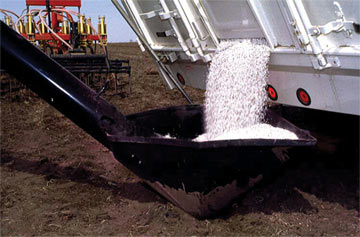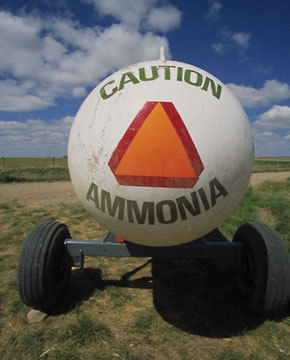| | Dry fertilizer storage | Liquid fertilizer storage | Fertilizer mixing and loading | Anhydrous ammonia | Application of fertilizers | Legislation | For more information
Fertilizers are organic and inorganic forms of nutrients that are used to support plant growth. Types of fertilizers include solid fertilizers (such as granules, crystals and pellets), liquid fertilizers and anhydrous ammonia (a compressed gas that is liquefied under pressure).
The potential hazards in fertilizers are the nutrients and salt concentrations within them. Two main concerns regarding fertilizer on the farm are the storage of the product and their use within the farmstead area.
Dry Fertilizer Storage
To properly store dry fertilizer, you need to:
- Avoid storing fertilizers with drinking water, food, fuel, seed, animal feeds or protective equipment to prevent contamination.
- Locate storage facility more than 100 m (330 ft) from water wells and more than 20 m (60 ft) from surface water bodies.
- Store on an impermeable surface such as sealed concrete. For field operations, storage should be in a building or epoxy-lined bin.
- Post signs stating the contents of the storage facility for large fertilizer amounts in case of an emergency or fire.
- Maintain and monitor the storage area, checking regularly for fertilizer leaks and spills.
- Ensure the storage facility is secure when storing large amounts of fertilizer. Building or storage bins should be separate from all other activities that could damage containers or spill fertilizer. This could mean a locked fenced area.
Liquid Fertilizer Storage
To properly store liquid fertilizer, you need to:
- Inspect all tanks, valves and plumbing used for large liquid fertilizer storage regularly.
- Ensure that you have adequate secondary containment to hold any spills or leaks.
- Use sight gauges and lock-on valves on large storage containers.

Use proper procedures and precautions when loading fertilizer at all times
Courtesy of PFRA
Fertilizer Mixing and Loading
When mixing and loading fertilizers, it is inevitable that a spill will occur. Using proper clean up procedures and precautions to minimize spills, you will reduce or eliminate environmental risks.
Follow these guidelines for proper fertilizer mixing and loading:
- Never leave filling procedures unattended.
- Ensure loading takes place at least 30 m (98 ft) away from a well or surface water.
- Clean up spills when they occur.
- For dry fertilizer, if you use a permanent mixing and loading area, the mixing pad should be impermeable. Sweep up any spilled dry fertilizer, and store it in a clean container until it can be used.
- For liquid fertilizer, if you use a permanent mixing and loading area, ensure that any spills or leaks can be collected and contained. The mixing pad should have an impermeable floor, curbs and a sump. Liquids from the sump can be used for future applications.
- For mixing liquid fertilizers, either have a backflow preventer on the water supply or ensure that there is a 15 cm (6 in) air gap between the hose and water source or supply. If possible, use a closed handling system to transfer the fertilizer directly from the storage container to the applicator equipment, so people and the environment are not exposed to the fertilizer.
Anhydrous Ammonia
Anhydrous ammonia is a corrosive, compressed gas that is liquefied under pressure. It can present significant health and safety risks if not handled and stored properly. Handlers and applicators should ensure all equipment is inspected prior to use, checking for properly functioning valves, breakaway couplers and ensuring all high-pressure hoses are free of cracks or wear. It is also very important never to assume all pressure has been released from hoses when working around equipment or when connecting or disconnecting hoses.

Anhydrous ammonia tank
Courtesy of ARD
Many regulations are in place to keep the use of anhydrous ammonia safe. All equipment and parts used for storing, transporting and applying anhydrous ammonia must be registered and inspected on a regular basis to meet strict design standards and pressure tests. Under federal law, anyone handling, offering for transport or transporting anhydrous ammonia must also complete Transportation of Dangerous Goods (TDG) training every three years.
Growers are responsible, as employers, to ensure anyone handling anhydrous ammonia on their farm receives TDG training, which is offered through most anhydrous ammonia retailers. Finally, anhydrous ammonia retailers have put 24-hour emergency response teams into place to ensure the safety of communities, equipment and the product.
Application of Fertilizers
To avoid potential risks associated with the application of fertilizers, ensure application rates do not exceed plant requirements. Too much fertilizer is not only economically wasteful, but nutrients applied beyond plant use may be lost. Nutrients lost through leaching and runoff may potentially contaminate surface water or groundwater sources. Ensure that fertilizer application rates are calculated and based on soil nutrient content and plant nutrient needs. Using soil tests to ensure proper amounts of nutrients are applied can help you reduce the level of environmental losses associated with excessive nutrients and extra costs associated with high application rates.
Many factors may affect the amount of nutrients available in the soil. These factors include plant type, soil type and soil moisture, as well as climatic factors such as rainfall, temperature and sunlight. Management factors that affect fertilizer nutrient availability include nutrient sources, application methods (broadcasting versus banding) and timing (spring versus fall).
Emergency plan
Every farmstead needs an emergency plan, which outlines the location of hazardous materials, emergency equipment, telephone numbers and necessary clean-up instructions. The plan gives those living on the farmstead guidelines to follow for minimizing potential environmental damage to the site, as well as protects those living on the site and in the surrounding community. For more information about emergency planning and the steps necessary to minimize environmental risk and ensure the safety of others, refer to the Appendix.
Legislation
Producers should be aware of the following pieces of legislation that pertain to fertilizers and the environmental risks associated with their use. For more information on legislation, refer to Chapter 12 of this manual.
Federal Legislation
Transportation of Dangerous Goods Act
Provincial Legislation
Agricultural Operation Practices Act
Environmental Protection and Enhancement Act
For More Information
All Alberta government offices may be reached toll-free by dialing the Rite Line: 310-0000
Alberta Agriculture and Forestry
Publications: 780-427-0391
Alberta Government Library: 780-427-2985
- Impacts of Farm Inputs (video loan)
Ag-Info Centre: 1-866-882-7677
Alberta Transportation
Publications: 1-800-272-9600
- Dangerous Goods and the Agricultural Industry
Canadian Association of Agri-Retailers
Publications: 204-989-9300
- Fertilizer Storage and Handling
Canadian Fertilizer Institute
Publications: 613-230-2600
- Canadian Fertilizer Industry Storage and Handling Guidelines 2001
|
|